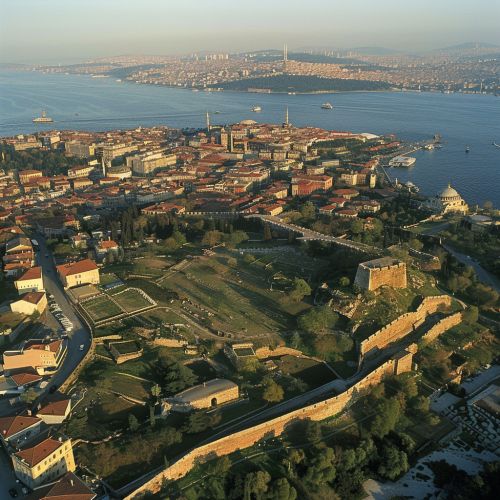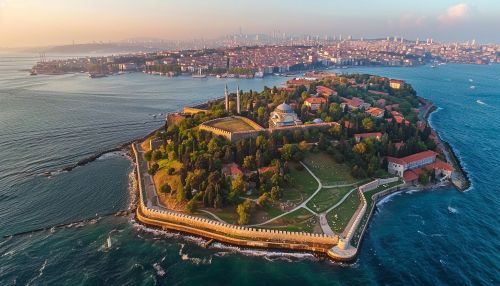Byzantium
Origins
Byzantium was an ancient city, the remnants of which are located in modern-day Istanbul, Turkey. It was founded by Greek colonists from Megara in 657 BC and named after their king, Byzas. The city was strategically located at the crossroads of Europe and Asia, on the European side of the Bosporus strait, which connects the Black Sea to the Sea of Marmara and the Mediterranean.


Roman and Byzantine Periods
In 196 AD, Byzantium was razed by the Roman emperor Septimius Severus, who then rebuilt it on a grand scale, renaming it Augusta Antonina in honor of his son. However, the city soon reverted to its original name. In 330 AD, the Roman Emperor Constantine I made Byzantium the new capital of the Roman Empire, renaming it Nova Roma; but the city soon became known as Constantinople, the "City of Constantine".
Constantinople became the largest and wealthiest city in Europe during the Middle Ages, and the center of the Eastern Orthodox Church. The city's wealth and strategic location attracted numerous invasions, but its formidable walls, built by Emperor Theodosius II in the 5th century, withstood most attacks until 1204, when the city was sacked during the Fourth Crusade.
Byzantine Empire
The Byzantine Empire, also referred to as the Eastern Roman Empire, was the continuation of the Roman Empire in its eastern provinces during Late Antiquity and the Middle Ages, when its capital city was Constantinople. It survived the fragmentation and fall of the Western Roman Empire in the 5th century AD and continued to exist for an additional thousand years until it fell to the Ottoman Turks in 1453.
The Byzantine Empire was a powerful economic, cultural, and military force in Europe and the Mediterranean. It was characterized by a complex system of government, a flexible and adaptable administrative structure, a strong economy, and a rich and distinctive culture. The empire's influence extended over a vast geographical area, from the British Isles and the Atlantic Ocean in the west to the Caucasians and the Persian Gulf in the east, and from the Danube River and the Black Sea in the north to the Sahara Desert and the Red Sea in the south.
Culture and Society
Byzantine culture was a synthesis of ancient Greek, Roman, and Christian elements, with influences from the Near East. The Byzantines excelled in the arts, architecture, literature, and philosophy. They preserved and transmitted the classical heritage of Greece and Rome, and their scholars made significant contributions to various fields of knowledge, including history, theology, law, and medicine.
Byzantine society was highly stratified, with a small aristocracy, a large bureaucracy, a substantial middle class, and a vast peasantry. The emperor was the absolute ruler, and the Orthodox Church played a central role in society. The Byzantines developed a unique style of art and architecture, characterized by a fusion of classical, Christian, and oriental motifs.
Decline and Fall
The decline of the Byzantine Empire was a long and complex process that began in the 11th century and culminated in the fall of Constantinople to the Ottoman Turks in 1453. The empire's decline was due to a combination of internal problems, such as political instability, economic difficulties, and social unrest, and external threats, such as invasions, wars, and the rise of powerful new states in Europe and Asia.
The fall of Constantinople marked the end of the Byzantine Empire and the end of the Middle Ages in Europe. It also marked the beginning of the Ottoman Empire and the rise of Islam as a major force in Europe. The fall of Constantinople had profound consequences for Europe and the world, and it remains a subject of intense interest and debate among historians.
Legacy
The legacy of Byzantium is vast and enduring. The Byzantine Empire played a crucial role in the transmission of classical knowledge to the Islamic world and to the West. It was a major center of Christian civilization and the Orthodox Church. Byzantine art and architecture had a profound influence on the Renaissance and the development of Western art. The Byzantine legal code, the Justinian Code, served as the basis for many modern legal systems. The Byzantine Empire also had a lasting impact on the history, culture, and identity of many nations in Europe and the Middle East.
